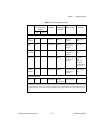
Chapter 3 Hardware Overview
DIO 6533 User Manual 3-8 © National Instruments Corporation
The pattern mask, which selects the bits that are significant for pattern
detection, also applies to change detection. The 6533 device monitors
only the significant bits for changes. After detecting a change, however,
the 6533 device captures the values of all bits.
Change detection can increase CPU and bus efficiency for control
applications. You can monitor activity on input lines without
continuously polling, and without transferring unnecessary data during
periods of inactivity.
After a change occurs, the 6533 device takes from 50to 150ns to clock
in the new data. Therefore, the resolution of change detection is 150ns.
Repeatedly changing data is also subject to the usual pattern generation
rate limits; see the Transfer Rates section in this chapter for more
information.
You can use change detection in conjunction with pattern detection.
Within a single group, the change and pattern detection masks are the
same; input lines that are significant for pattern detection are also
significant for change detection.
Message Generation
Some software environments, such as LabVIEW and
LabWindows/CVI, support message generation. Messages allow you to
run a user-specified routine when a particular data acquisition event
occurs. For example:
• Generate a message upon acquisition of a specified input pattern
• Generate a message every time the 6533device transfers a data
point. You can apply this option to change-detection mode to
generate a message every time the input data changes.
These message-generation options can extend your pattern and
change-detection capabilities. Some message-generation options
require that you select interrupt-driven rather than DMA transfers. See
your software documentation for further information about messages.
Handshaking Protocols
When you perform full, two-way handshaking operations, you can
select among several timing protocols offered by the 6533 devices. The
protocol you select determines the timing of the ACK signals that the
6533 device sends to the peripheral device and of the REQ signals


















